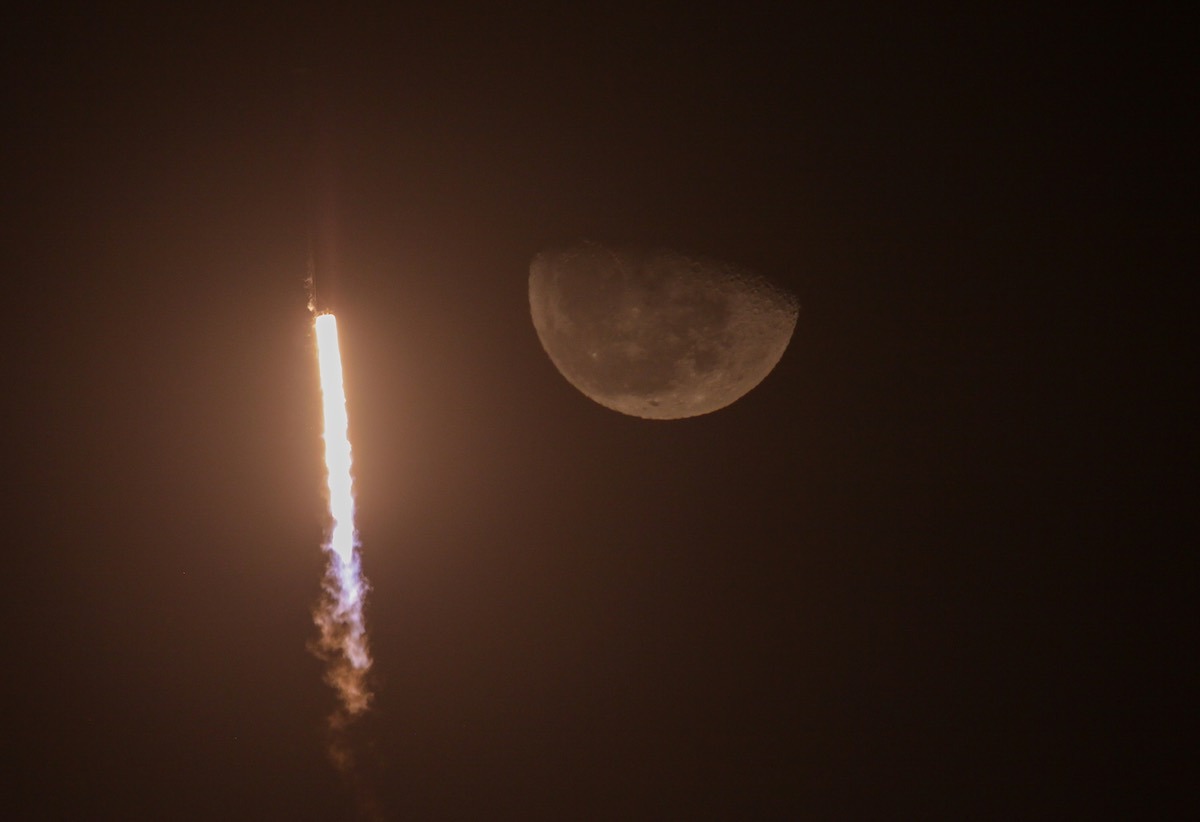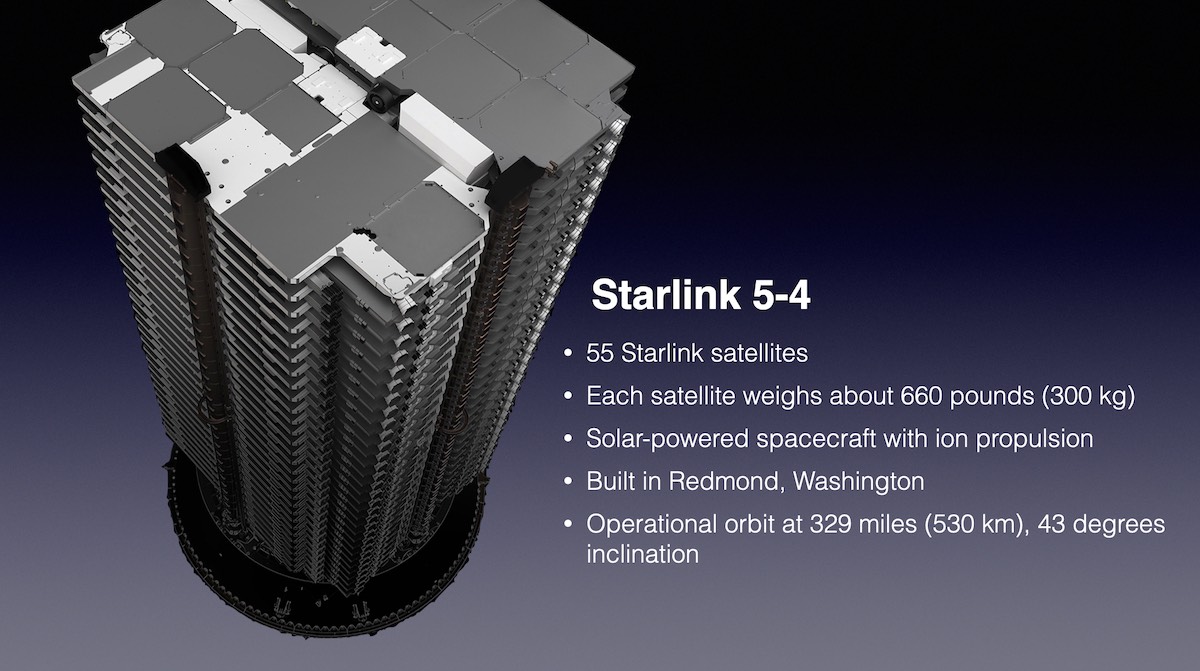13.02.2023

A SpaceX Falcon 9 rocket hauled 55 more Starlink internet satellites into orbit just after midnight Sunday from Cape Canaveral, breaking a record for the shortest time between missions — five days — from the same SpaceX launch pad.
The mission was SpaceX’s 10th launch of the year, a pace of one launch every four days since Jan. 1. SpaceX is aiming to launch up to 100 Falcon rocket missions this year from launch pads in Florida and California, while teams in Texas ready for the first orbital test flight of the company’s giant new Starship launch vehicle.
SpaceX fired up the Starship rocket’s Super Heavy booster for a major ground test Thursday at the Starbase facility in South Texas. The booster ignited 31 of its 33 Raptor engines for a hold-down test-firing, as SpaceX hopes to ready the nearly 40-story-tall rocket for its inaugural launch later this spring.
For Sunday’s overnight mission from Florida, SpaceX employed its workhorse Falcon 9 rocket for another flight to deploy satellites for the Starlink internet network. With the 55 new satellites that traveled to space on Sunday’s mission, SpaceX has now launched 3,930 Starlink spacecraft since the first prototypes in 2018. That number includes test satellites no longer in service, and satellites that have already re-enter the atmosphere.
Liftoff of the 229-foot-tall (70-meter) Falcon 9 rocket from pad 40 at Cape Canaveral Space Force Station occurred at 12:10:10 a.m. EST (0510:10 GMT) Sunday, defying a poor weather forecast to get off the ground before rain showers and brisk winds moved through the spaceport with the passage of a frontal boundary.
The 55 Starlink internet satellites mounted on top of the Falcon 9 rocket headed into an orbital plane that is part of SpaceX’s second-generation Starlink network, called Gen2. Sunday’s mission, known as Starlink 5-4, followed the first three Starlink launches into the Gen2 network in December and January.
The launch occurred five days, three hours, and 38 minutes after SpaceX’s previous mission from pad 40 at Cape Canaveral, which carried a Spanish-owned communications satellite into orbit. That set a record for the shortest turnaround time between SpaceX launches from the same pad as the company continues to ramp up its blistering launch cadence.
SpaceX plans to eventually launch second-generation Starlink satellites on the new Starship mega-rocket. Those satellites will be larger and more capable than SpaceX’s current fleet of Starlink spacecraft, and will be capable of transmitting signals directly to cell phones. But with the Starship rocket still undergoing preparations for its first orbital test flight, SpaceX officials signaled they will start launching the Gen2 satellites on Falcon 9 rockets.
Elon Musk, SpaceX’s founder and CEO, suggested in August that the company could develop a miniature version of the Gen2 satellites to fit on the Falcon 9 rocket.
The satellites on the first three Gen2 launches appeared similar, or identical, to Starlink spacecraft SpaceX is already launching to complete its first-generation network, and not the larger Gen2 satellites destined to fly on the huge new Starship rocket, or even the mini Gen2 satellites Musk mentioned last year.
The Federal Communications Commission granted SpaceX approval Dec. 1 to launch up to 7,500 of its planned 29,988-spacecraft Starlink Gen2 constellation. The regulatory agency deferred a decision on the remaining satellites SpaceX proposed for Gen2. With the launch Sunday, SpaceX will have flown 213 Starlink Gen2 satellites into orbit.
“Under our new license, we are now able to deploy satellites to new orbits that will add even more capacity to the network,” SpaceX wrote on its website before the first Gen2 launch Dec. 28. “Ultimately, this enables us to add more customers and provide faster service – particularly in areas that are currently over-subscribed.”
The FCC previously authorized SpaceX to launch and operate up to 12,000 Starlink satellites, including roughly 4,400 first-generation Ka-band and Ku-band Starlink spacecraft that SpaceX has been launching since 2019. SpaceX also received regulatory approval to launch more than 7,500 Starlink satellites operating in a different V-band frequency.
SpaceX told the FCC last year it planned to consolidate the V-band Starlink fleet into the larger Gen2 constellation.
The Gen2 satellites could improve Starlink coverage over lower latitude regions, and help alleviate pressure on the network from growing consumer uptake. SpaceX said in December the network has more than 1 million active subscribers. The Starlink spacecraft beam broadband internet signals to consumers around the world, connectivity that is now available on all seven continents with testing underway at a research station in Antarctica.
Earlier this month, SpaceX announced Starlink service is now available in Brazil, Colombia, and Italy.
“Our action will allow SpaceX to begin deployment of Gen2 Starlink, which will bring next generation satellite broadband to Americans nationwide, including those living and working in areas traditionally unserved or underserved by terrestrial systems,” the FCC wrote in its Dec. 1 order partially approving the Starlink Gen2 constellation. “Our action also will enable worldwide satellite broadband service, helping to close the digital divide on a global scale.
“At the same time, this limited grant and associated conditions will protect other satellite and terrestrial operators from harmful interference and maintain a safe space environment, promoting competition and protecting spectrum and orbital resources for future use,” the FCC wrote. “We defer action on the remainder of SpaceX’s application at this time.”
Specifically, the FCC granted SpaceX authority to launch the initial block of 7,500 Starlink Gen2 satellites into orbits at 525, 530, and 535 kilometers, with inclinations of 53, 43, and 33 degrees, respectively, using Ku-band and Ka-band frequencies. The FCC deferred a decision on SpaceX’s request to operate Starlink Gen2 satellites in higher and lower orbits.
Like the first three Starlink Gen2 launches, the Starlink 5-4 mission Sunday targeted the 530-kilometer-high (329-mile) orbit at an inclination of 43 degrees to the equator.

SpaceX currently has nearly 3,500 functioning Starlink satellites in space, with more than 3,100 operational and roughly 300 moving into their operational orbits, according to a tabulation by Jonathan McDowell, an expert tracker of spaceflight activity and an astronomer at the Harvard-Smithsonian Center for Astrophysics.
The first-generation Starlink network architecture includes satellites flying a few hundred miles up, orbiting at inclinations of 97.6 degrees, 70 degrees, 53.2 degrees, and 53.0 degrees to the equator. Last year, most of SpaceX’s Starlink launches have released satellites into Shell 4, at an inclination of 53.2 degrees, after the company largely completed launches into the first 53-degree inclination shell in 2021.
Shell 5 of the Starlink network was widely believed to be one of the polar-orbiting layers of the constellation, at 97.6 degrees inclination. But the name of the first Gen2 missions — Starlink 5-1, 5-2, 5-3, and 5-4 — appear to suggest SpaceX has changed the naming scheme for the Starlink shells.
SpaceX’s launch team was stationed inside a launch control center just south of Cape Canaveral Space Force Station for the overnight countdown ahead of Sunday’s flight. SpaceX began loading super-chilled, densified kerosene and liquid oxygen propellants into the Falcon 9 vehicle at T-minus 35 minutes.
Helium pressurant also flowed into the rocket in the last half-hour of the countdown. In the final seven minutes before liftoff, the Falcon 9’s Merlin main engines were thermally conditioned for flight through a procedure known as “chilldown.” The Falcon 9’s guidance and range safety systems were also configured for launch.
After liftoff, the Falcon 9 rocket vectored its 1.7 million pounds of thrust — produced by nine Merlin engines — to steer southeast over the Atlantic Ocean. SpaceX has resumed launches this winter using the southeasterly corridor from Cape Canaveral, rather than trajectories to the northeast, to take advantage of better sea conditions for landing of the Falcon 9’s first stage booster.
Throughout the summer and fall, SpaceX launched Starlink missions on paths toward the northeast from Florida’s Space Coast.
The Falcon 9 rocket exceeded the speed of sound in about one minute, then shut down its nine main engines two-and-a-half minutes after liftoff. The booster stage separated from the Falcon 9’s upper stage, then fired pulses from cold gas control thrusters and extended titanium grid fins to help steer the vehicle back into the atmosphere.
Two braking burns slowed the rocket for landing on the drone ship “A Shortfall of Gravitas” around 410 miles (660 kilometers) downrange approximately eight-and-a-half minutes after liftoff. The reusable booster, designated B1062 in SpaceX’s inventory, completed its 12th trip to space Sunday.
The Falcon 9’s reusable payload fairing jettisoned during the second stage burn. A recovery ship was also on station in the Atlantic to retrieve the two halves of the nose cone after they splashed down under parachutes.
Landing of the first stage on Sunday’s mission occurred just as the Falcon 9’s second stage engine cut off to deliver the Starlink satellites into a preliminary parking orbit. Another upper stage burn 54 minutes into the mission reshaped the orbit ahead of payload separation.
Separation of the 55 Starlink spacecraft, built by SpaceX in Redmond, Washington, from the Falcon 9 rocket was confirmed 63 minutes after liftoff.
The Falcon 9’s guidance computer aimed to deploy the satellites into an orbit at an inclination of 43 degrees to the equator, with an altitude ranging between 185 miles and 210 miles (298-by-339 kilometers). After separating from the rocket, the 55 Starlink spacecraft will unfurl solar arrays and run through automated activation steps, then use ion engines to maneuver into their operational orbit.
ROCKET: Falcon 9 (B1062.12)
PAYLOAD: 55 Starlink satellites (Starlink 5-4)
LAUNCH SITE: SLC-40, Cape Canaveral Space Force Station, Florida
LAUNCH DATE: Feb. 12, 2023
LAUNCH TIME: 12:10:10 a.m. EST (0510:10 GMT)
WEATHER FORECAST: 20% chance of acceptable weather; Moderate risk of upper level winds; Low risk of unfavorable conditions for booster recovery
BOOSTER RECOVERY: “A Shortfall of Gravitas” drone ship northeast of the Bahamas
LAUNCH AZIMUTH: Southeast
TARGET ORBIT: 185 miles by 210 miles (298 kilometers by 339 kilometers), 43.0 degrees inclination
LAUNCH TIMELINE:
- T+00:00: Liftoff
- T+01:12: Maximum aerodynamic pressure (Max-Q)
- T+02:28: First stage main engine cutoff (MECO)
- T+02:31: Stage separation
- T+02:38: Second stage engine ignition (SES 1)
- T+02:45: Fairing jettison
- T+06:17: First stage entry burn ignition (three engines)
- T+06:35: First stage entry burn cutoff
- T+08:12: First stage landing burn ignition (one engine)
- T+08:32: First stage landing
- T+08:39: Second stage engine cutoff (SECO 1)
- T+54:12: Second stage engine ignition (SES 2)
- T+54:14: Second stage engine cutoff (SECO 2)
- T+1:03:15: Starlink satellite separation
MISSION STATS:
- 203rd launch of a Falcon 9 rocket since 2010
- 213th launch of Falcon rocket family since 2006
- 12th launch of Falcon 9 booster B1062
- 174th SpaceX launch from Florida’s Space Coast
- 113th Falcon 9 launch from pad 40
- 168th launch overall from pad 40
- 144th flight of a reused Falcon 9 booster
- 72nd Falcon 9 launch primarily dedicated to Starlink network
- 9th Falcon 9 launch of 2023
- 10th launch by SpaceX in 2023
- 8th orbital launch attempt based out of Cape Canaveral in 2023
Quelle: SN
